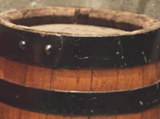
Barrel Aging Wine Before Bottling
Wine Kitz Dartmouth offers barrel aging for those of you who appreciate more complexity in your wines.
How it Works
After fermentation is completed, your wine is racked to remove the largest sediments, and then filtered. The young wine is usually rough, raw and “green,” and needs to settle and age for a period of time.
This aging can be done in neutral containers such as stainless steel, glass carboys, cement lined vats, old large casks, etc., or it can be done in small, oak barrels. These are not neutral; they influence the developing wine as it rests in the barrel. The wine goes through subtle chemical changes, resulting in greater complexity and a softening of the harsh tannins and flavors present at the end of fermentation.
Why Would You Want This?
An oak barrel essentially does two things: it allows a very slow introduction of oxygen into the wine; and it imparts the character of the wood into the wine. For red wines, controlled oxidation takes place during barrel aging. This very gradual oxidation results in decreased astringency and increased colour and stability. It also evolves the fruit aromas to more complex ones.
